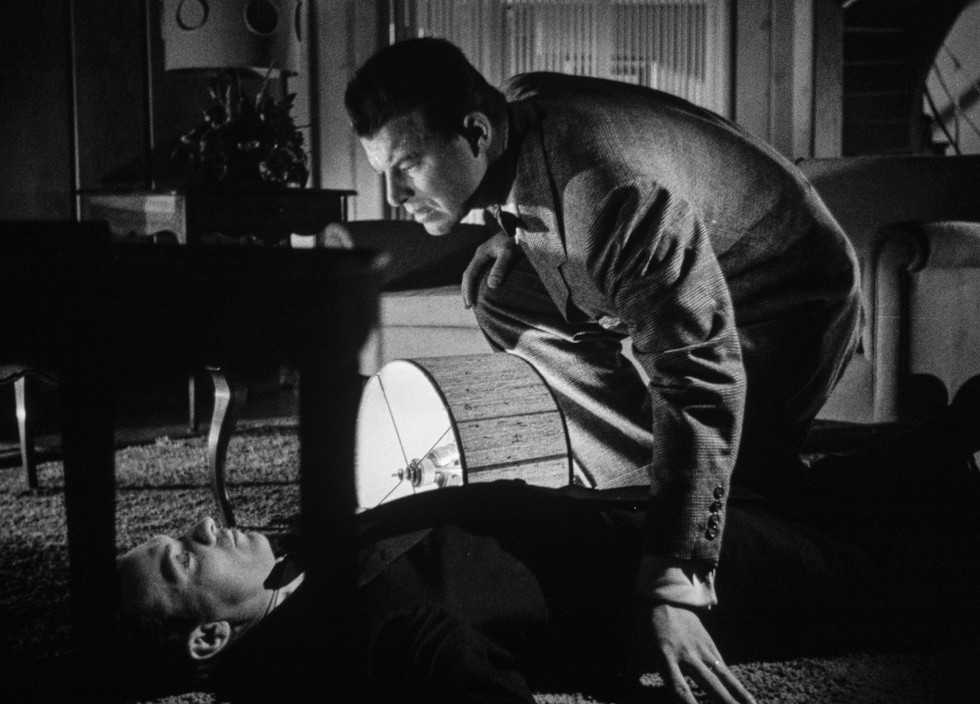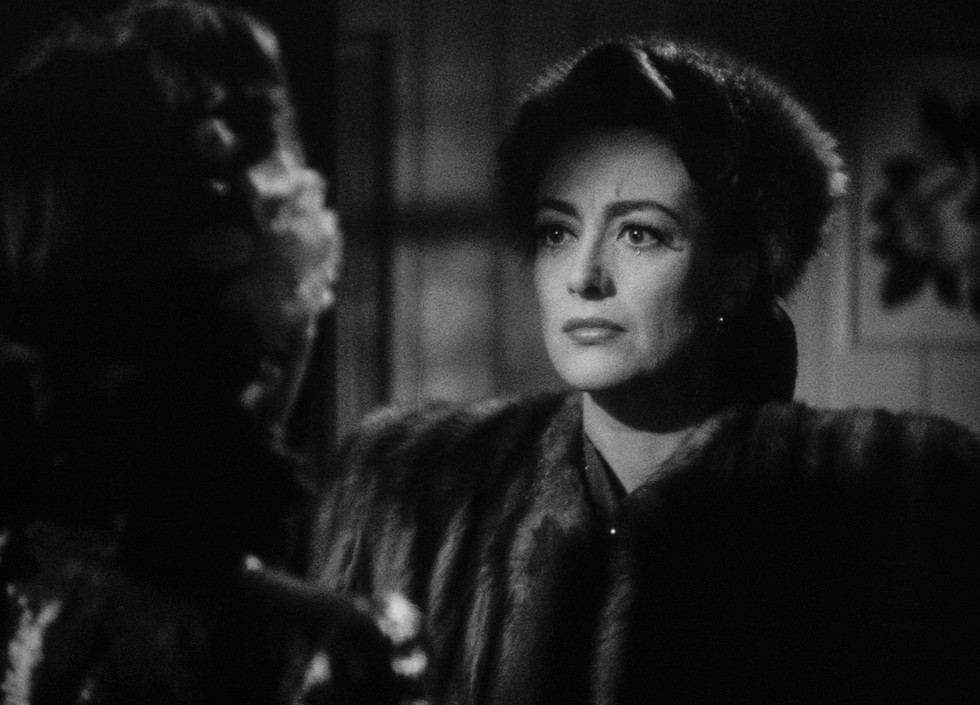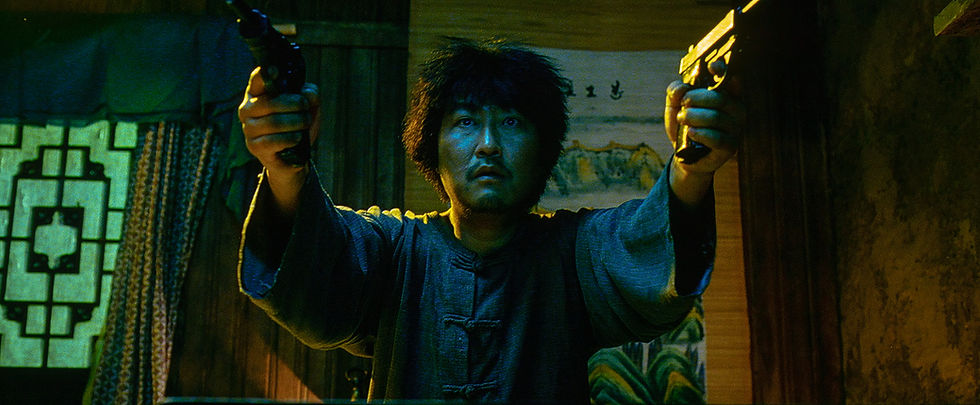Blending film noir & melodrama, “Mildred Pierce: Criterion Collection” gets the 4K treatment
- Bill Kelley III

- Mar 20, 2023
- 6 min read
4K ULTRA HD REVIEW / HDR FRAME SHOTS
Joan Crawford won an Oscar for Best Actress as Mildred Pierce, a businesswoman, mother, and wife.
(Click an image to scroll the larger versions)
“MILDRED PIERCE: THE CRITERION COLLECTION”
4K Ultra HD & Blu-ray; 1945; Not Rated
Best extra: “Joan Crawford: The Ultimate Movie Star” documentary
SIX YEARS AGO, The Criterion Collection released Warner Brothers 4K restoration of the film noir classic “Mildred Pierce.”
The Blu-ray was sourced from varying film elements – the original 35mm camera negative and a second-generation fine-grain master both scanned in 4K. In 1080p the imagery melded together nicely, especially since the camera negative frames were downconverted to 1080p, which matched closer to the lesser fine-grain master. This is not uncommon, since older films have unrepairable frames and sections forcing lesser elements into the assemblage. This time a print from the Museum of Modern Art in New York filled the gaps, which showed a slight reduction of sharpness and contrast level.
(1&2) Mildred’s second husband, Monte Beragon (Zachary Scott), is murdered in her beachfront house. (3-6) She ends up at an oceanfront fishing pier and considers suicide, but is stopped by a patrol officer.
VIDEO/AUDIO
First off, the higher resolution of the Criterion 4K disc makes the disparity between the camera negative and fine-grain master more apparent. Overall, it has impeccable sharpness and uniform grayscale with the added HDR10 grading handled by Criterion’s Lee Kline. Especially the scenes sourced from the camera negative, which perfectly highlights the stylized photography from cinematographer Ernest Haller (“Gone with the Wind,” “What Ever Happened to Baby Jane?”).
The 4K restoration also removed tens of thousands of scratches, dirt, and marks, while the peak HDR10 brightness hits 152 nits, and only averaged 29 nits. Even with the low numbers, the shadows are darker and richer adding to the mood, while the mid-tones are fuller and slightly darker. Possibly the great addition is the increased 25 to 40 Megabits per second in video over the 1080p disc. Meaning each frame is getting between 1 to 2 megabits more clarity and defined grain structure.
On the audio front, the original mono track was remastered removing clicks, hum, and pops for a straightforward soundtrack that includes another classic score from Warner Brothers’ composer Max Steiner.
(1) Longtime friend and former business partner Wally Fay (Jack Carson) spots Mildred and asks her into his club at the pier. (2) She convinces Wally to go to her beach house because her liquor isn’t “rotten.” (3&4) Mildred disappears from the house and leaves Wally to discover her dead husband. (5) Police discover Wally outside after smashing a glass doorway.
IN THE grand decade of the 1940s, Warner was at the top of its game – and it’s obvious during the sensational opening of “Mildred Pierce.”
Three gunshots ring out 10 seconds in. After a quick cut from outside a beach house to an interior living room, three more blasts follow – two hitting a mirror behind a man in a black suit and bow tie. He bellies over as director Michael Curtiz’s (“Casablanca,” “The Adventures of Robin Hood,” “White Christmas”) camera follows him to the floor; a flickering fireplace lights the room. The gun is thrown toward the dying man as he breathes his last word, “Mildred.”
EXTRAS
Author and film critic Robert Polito calls the opener a “Rosebud moment,” in a video conversation with fellow critic Molly Haskell on the enclosed Blu-ray. It’s a reference to Orson Welles’ “Citizen Kane” (1941) famous opening. Here, it’s the start of Mildred Pierce’s story – a businesswoman, a mother, and wife, superbly played by Joan Crawford, who won her only Oscar for Best Actress.
The two critics dissect the classic Warner melodrama with its snappy, salty script based on James M. Cain’s 1941 novel of “poisoned class and money,” film historian Imogen Sara Smith writes in the enclosed essay. Haskell describes the tale as “a mink coat and a gun.” We first spot Mildred walking along an oceanfront-fishing pier in the night air, wearing a long fur coat and ankle-strap high heels; a close-up reveals tears rolling down her face.
The Murder Investigation
(1&2) Mildred returns to her Pasadena mansion to find the police and her daughter Veda (Ann Blyth) waiting for her. (3-5) Throughout the night prime suspects including ex-husband Bert Pierce (Bruce Bennett) are questioned by Inspector Peterson (Moroni Olsen).
“Mildred Pierce” has been unappreciated for years. Polito recalls his first viewing decades ago; he wasn’t sure what to make of it. “It was all over the place,” he says. But, over time, he’s come to respect it as two films in one. The scene at the beach house he considers the exterior, the murder of Mildred’s second husband Monte Beragon played by Zachary Scott. It puts Mildred front and center in the mystery. “The power of the movie is it doesn’t settle for easy answers,” he says.
The second film within “Mildred” is what Polito calls the “woman’s picture.” It starts with her voiceover from the police station while being questioned for murder. The flashback opens by showing her life as a mother/wife, who sells cakes and pies out of her suburban kitchen in Glendale, California, to provide niceties (clothes, piano, and ballet lessons) for her two daughters. Her first marriage to Bert (Bruce Bennett) is on the rocks. He feels she’s too fixated on the girls. Having just lost his real estate job, Bert seems more interested in Mrs. Biederhof (Lee Patrick). Haskell chimes in tagging “Mildred” as classic film noir, with a trademark voiceover flashback, unique in that it comes from a woman’s point of view.
Haskell also describes how George Cukor, who directed Crawford in “The Women” (1939), admired her no-fear approach to the camera. “I could dolly right onto her and she won’t even blink,” Cukor once said.
Both critics agree the three male characters are weak and flawed, and “ultimately disappoint Mildred.” But Haskell recognizes Jack Carson, who plays Wally Fay, as exciting and interesting, a longtime friend of Mildred’s and a partner in her diner franchise. He’s had a crush on her for years and is always flirting with her. “Wally, you should be put on a leash,” she tells him.
Ultimately, what keeps “Mildred” from a straightforward woman’s picture is its manipulative, self-obsessed young femme fatale Veda, Mildred’s teenaged daughter played by Ann Blyth, writes Smith. The 16-year-old was nominated for Best Supporting Actress. “Mildred Pierce” also received nominations for Best Picture, Best Writing, and Best Cinematography – Black and White.
(1&2) The story becomes a flashback as Mildred tells of their Glendale suburban home “where all the houses look alike.” She and Bert end up separated and to pay the bills she finds a job as a waitress while making cakes and pies on the side for piano and ballet lessons for her two daughters. Eventually, she wants to start her own restaurant and convinces Wally to be a partner and Monte Beragon joins as a silent partner - an heir to a once-wealthy Pasadena family. (3) Monte invites Mildred to his oceanfront home and they become romantic. (4) Mildred’s youngest daughter Kay (Jo Ann Marlowe) comes down with pneumonia. (5) Bert and Beragon have a confrontation.
Additional bonus features include a 90-minute documentary, “Joan Crawford: The Ultimate Movie Star” narrated by Anjelica Huston, that originally aired on TCM in 2003. Crawford biographer Bob Thomas called her career a great tragedy, underlining the 1978 revelation from her adopted daughter, Christina, calling her a cruel and abusive, alcoholic mother. The documentary interviews journalists, Christina, and a number of close friends and actors including Anita Page, Cliff Robertson, Anne Blyth, director Vincent Sherman, and columnist Liz Smith as they highlight Crawford’s career of nearly 100 motion pictures. Plus, it explores her impoverished childhood as Lucille Le Sueur, her stage starts as a Broadway chorus girl, and her first contract with MGM in 1925, as well as her rocky personal life. Known as a Hollywood party girl, Crawford married four times, first to Douglas Fairbanks Jr. She had numerous lovers including Clark Gable and Spencer Tracy, was obsessed with gardenias, loved knitting to help control a nervous hand, was an obsessive-compulsive cleaner and adopted four children.
There’s also a delightful 1970 interview with Crawford on the “David Frost Show,” in which she wears a flashy pink dress and hat. She divulges her favorite homemade dish – pork chops and baked beans – plus how she bought three off-the-rack dresses at Sears and Roebuck for her screen test for “Mildred Pierce,” and how she missed the Academy Awards with a temperature of 104, but accepted her golden statue from her bedside that night, inviting the press over for photos once she heard the news.
And there’s a 1969 interview with author James M. Cain on NBC’s “Today Show” and a 2002 Q&A with actress Ann Blyth.
Hats off to Criterion for unearthing one of Warner Brothers’ prized treasures from the golden age as the studio celebrates its 100th Anniversary.
― Bill Kelley III, High-def Watch producer
(1-3) Mildred soon owns a chain of restaurants and buys a new car for Veda, who becomes the manipulative, self-obsessed young femme fatale. (4) Mildred is shocked by her daughter.
























































Comments